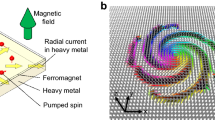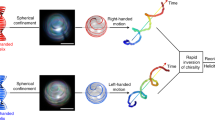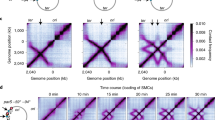Abstract
DARLINGTON1 suggested that the coiling systems encountered in chromosomes are determined by spiral structures at the molecular level. Interest in the replication of spirals and in the separation in double spirals has been renewed recently2–4 following proposals of helical structures for deoxyribonueleic acid2 and for various proteins5. Some of the difficulties in the disentangling of twin spirals are simplified if the spirals are free to rotate about their axes, as may be demonstrated using the simple model here described.
This is a preview of subscription content, access via your institution
Access options
Subscribe to this journal
Receive 51 print issues and online access
$199.00 per year
only $3.90 per issue
Buy this article
- Purchase on Springer Link
- Instant access to full article PDF
Prices may be subject to local taxes which are calculated during checkout
Similar content being viewed by others
References
Darlington, C. D., “Recent Advances in Cytology” (Churchill, London, 1937).
Watson, J. D., and Crick, F. H. C., Nature, 171, 737 (1953).
Delbrück, M., Proc. U.S. Nat. Acad. Sci., 40, 783 (1954).
Gamow, G. (in the press).
Pauling, L., and Corey, R. B., Proc. U.S. Nat. Acad. Sci., 37, 235 (1951).
Dalgleish, C. E., Nature, 171, 1027 (1953).
Author information
Authors and Affiliations
Rights and permissions
About this article
Cite this article
PERSON, C. A Model for manipulating Spirals. Nature 178, 221–222 (1956). https://doi.org/10.1038/178221a0
Issue Date:
DOI: https://doi.org/10.1038/178221a0
Comments
By submitting a comment you agree to abide by our Terms and Community Guidelines. If you find something abusive or that does not comply with our terms or guidelines please flag it as inappropriate.



